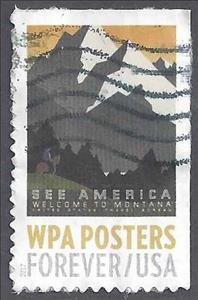Stamp: WPA Posters: See America (United States of America 2017)
WPA Posters: See America (United States of America 2017)
07 March (United States of America ) within release WPA Posters goes into circulation Stamp WPA Posters: See America face value FOREVER No Face Value
| Stamp WPA Posters: See America in catalogues | |
|---|---|
| Michel: | Mi: US 5373BEro |
Stamp is vertical format.
Initial value: 49cAlso in the issue WPA Posters:
- Stamp - WPA Posters: Work Pays America face value FOREVER;
- Stamp - WPA Posters: Hiking face value FOREVER;
- Stamp - WPA Posters: Municipal Airports face value FOREVER;
- Stamp - WPA Posters: Puerto Rico face value FOREVER;
- Stamp - WPA Posters: National Parks face value FOREVER;
- Stamp - WPA Posters: Field Day face value FOREVER;
- Stamp - WPA Posters: Visit The Zoo face value FOREVER;
- Stamp - WPA Posters: Work with Care face value FOREVER;
- Booklet - WPA Posters booklet face value 20*FOREVER;
- Stamp - WPA Posters: Foreign Trade Zone face value FOREVER;
- Stamp - WPA Posters: See America face value FOREVER;
- Se-tenant - Posters of the Works Projects Administration face value 3.92;
- Stamp - WPA Posters: See America face value FOREVER;
- Stamp - WPA Posters: Foreign Trade Zone face value FOREVER;
Stamp WPA Posters: See America it reflects the thematic directions:
A landscape is the visible features of an area of land, its landforms and how they integrate with natural or man-made features. A landscape includes the physical elements of geophysically defined landforms such as (ice-capped) mountains, hills, water bodies such as rivers, lakes, ponds and the sea, living elements of land cover including indigenous vegetation, human elements including different forms of land use, buildings and structures, and transitory elements such as lighting and weather conditions. Combining both their physical origins and the cultural overlay of human presence, often created over millennia, landscapes reflect a living synthesis of people and place that is vital to local and national identity. The character of a landscape helps define the self-image of the people who inhabit it and a sense of place that differentiates one region from other regions. It is the dynamic backdrop to people’s lives. Landscape can be as varied as farmland, a landscape park, or wilderness. The earth has a vast range of landscapes, including the icy landscapes of polar regions, mountainous landscapes, vast arid desert landscapes, islands and coastal landscapes, densely forested or wooded landscapes including past boreal forests and tropical rainforests, and agricultural landscapes of temperate and tropical regions.
A poster is a large sheet that is placed either on a public space to promote something or on a wall as decoration. Typically, posters include both textual and graphic elements, although a poster may be either wholly graphical or wholly text. Posters are designed to be both eye-catching and informative. Posters may be used for many purposes. They are a frequent tool of advertisers (particularly of events, musicians, and films), propagandists, protestors, and other groups trying to communicate a message. Posters are also used for reproductions of artwork, particularly famous works, and are generally low-cost compared to the original artwork. The modern poster, as we know it, however, dates back to the 1840s and 1850s when the printing industry perfected colour lithography and made mass production possible


